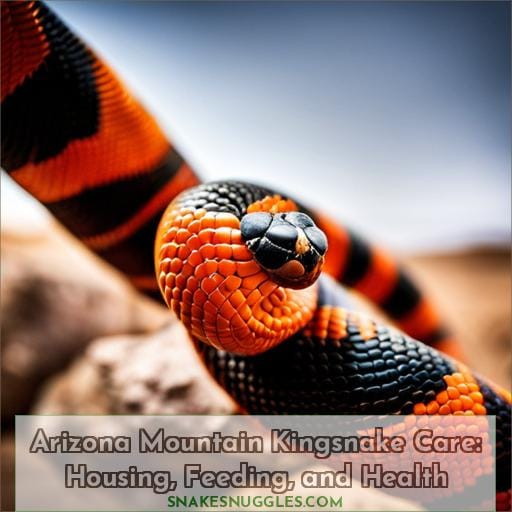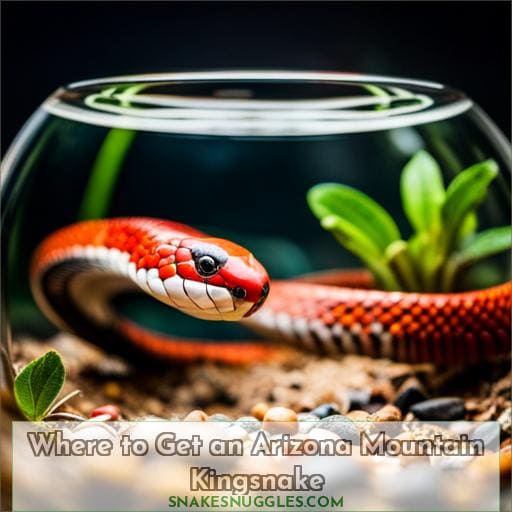This site is supported by our readers. We may earn a commission, at no cost to you, if you purchase through links.
 Immerse yourself in the captivating world of Arizona Mountain Kingsnake care. From housing to feeding and maintaining their health, this article will empower you with essential knowledge for providing optimal care for these majestic creatures.
Immerse yourself in the captivating world of Arizona Mountain Kingsnake care. From housing to feeding and maintaining their health, this article will empower you with essential knowledge for providing optimal care for these majestic creatures.
- Creating a suitable habitat
- Ensuring proper nutrition
- Managing temperature and humidity levels
- Addressing shedding issues
- Preventing common health problems
- Understanding behavior patterns
Get ready to become an expert caretaker of Arizona Mountain Kingsnakes!
Table Of Contents
Key Takeaways
- Provide a medium-sized vivarium with a tight-fitting lid.
- Feed a diet of mice/rats proportional to the snake’s size.
- Monitor for parasites, dehydration, and regurgitation.
- Specific spring breeding season.
Description
The Arizona Mountain Kingsnake, scientifically known as Lampropeltis p. pyromelana, is a tri-colored snake with red being the prominent band. These snakes can reach up to 42 inches in length when they reach adulthood. They’re native to wooded areas in Chihuahua and Sonora, Mexico.
When it comes to their care requirements, it’s important to provide them with escape-proof cages that have water and hiding areas available for them. In terms of behavior, these snakes are nocturnal creatures who prefer active during the night time hours.
To ensure proper care for your Arizona Mountain Kingsnake, make sure you create a suitable habitat that mimics their natural environment by using appropriate substrate materials such as wood chips or artificial grass mats.
Captive Care
When it comes to captive care for Arizona Mountain Kingsnakes, there are several important factors to consider.
First and foremost is housing – these snakes require a medium-sized vivarium with appropriate hides and climbing structures.
Feeding is also crucial, with a diet consisting mainly of mice or rats.
Temperature and humidity levels should be carefully regulated in order to create the optimal environment for these snakes.
Lastly, understanding the shedding process is essential as it occurs periodically throughout their lives.
Housing
When caring for an Arizona Mountain Kingsnake, you should regularly provide them with a suitable housing setup.
A medium-sized vivarium or fish tank with a tight-fitting lid will suffice.
The size of the enclosure should be appropriate for the snake’s length and allow room for movement.
It’s important to include essential elements such as a heat mat or bulb, water bowl, substrate (such as aspen shavings or newspaper), and hides (cardboard boxes or flower pots).
Proper housing ensures the snake’s comfort and well-being.
Feeding
To properly care for an Arizona Mountain Kingsnake, you’ll need to provide a suitable diet.
In the wild, these snakes eat a varied diet of rodents, birds, amphibians, and other reptiles.
In captivity, they can be fed entirely on mice or rats and still maintain good health.
It’s important to offer appropriately sized meals that are proportional to the snake’s size.
Adults typically require feeding every 7-10 days while juveniles may need food more frequently.
Temperature and Humidity
Maintaining proper temperature and humidity levels is crucial for the health and well-being of your Arizona Mountain Kingsnake.
To ensure optimal conditions, provide a heat mat with a thermostat or a light bulb attached to a dimming stat on the roof of the vivarium.
While kingsnakes don’t require specific humidity levels, occasional misting can help raise humidity during shedding.
Additionally, always provide fresh water in a sturdy bowl for drinking and bathing purposes.
| Temperature | Humidity |
|---|---|
| 75-85°F | 40-60% |
Shedding
To ensure the health and well-being of your Arizona Mountain Kingsnake, it’s important to understand their shedding process.
Before shedding, known as ecdysis, your snake will go through preecdysis. During this time, you may notice a dulling of their skin color and general inactivity.
Most snakes can shed without help, but some may experience shedding problems that require assistance. Maintaining the proper humidity level in their enclosure can help facilitate successful shedding and prevent respiratory infections.
Common Health Problems
Now it’s time to address the common health problems that can affect Arizona Mountain Kingsnakes.
- Internal and external parasites
- Dehydration and regurgitation
- Shedding problems
- Preventing illnesses
It’s important to be aware of these issues in order to provide proper care for your snake and maintain its overall health.
Internal and External Parasites
Internal and external parasites are common health problems that can affect Arizona Mountain Kingsnakes, so it’s important to be aware of these issues and take steps to prevent them.
Some examples of internal parasites include pinworms and roundworms, while external parasites can include mites and ticks. These ectoparasites can cause irritation, skin infections, or even transmit diseases.
To treat parasitic infestations in your snake, consult a veterinarian who may prescribe antiparasitic drugs or antibiotics if necessary for their health.
Regular check-ups are crucial for breeding snakes like the Arizona Mountain Kingsnake in order to detect any potential parasite-related issues early on.
Dehydration and Regurgitation
Dehydration and regurgitation are two common health problems that Arizona Mountain Kingsnakes may experience.
Dehydration can occur if the snake doesn’t have access to a sufficient water source or if the humidity levels in its enclosure are too low.
To prevent dehydration, ensure your snake has clean water available at all times and maintain appropriate humidity levels.
Regurgitation can be caused by overfeeding, improper temperatures during digestion, or stress. If your snake regurgitates its food, it’s important to monitor its feeding schedule and provide an optimal environment for digestion.
Shedding Problems
If your Arizona Mountain Kingsnake is experiencing shedding problems, there are several steps you can take to help facilitate the process.
Before shedding, your snake will go through a stage called pre-ecdysis. During this time, their skin color may dull and their eyes will turn a bluish grey.
If your snake has difficulty shedding completely or has stuck shed on certain areas of its body, it may be necessary to assist in removing the retained eye caps or seek veterinary assistance if needed.
Preventing Illnesses
To prevent common illnesses in your Arizona Mountain Kingsnake, regularly monitor its health and provide proper care.
This includes:
- Maintaining a clean enclosure
- Ensuring a good diet
- Managing stress levels
- Practicing proper husbandry techniques
Regular vet checkups are also important for early detection of any potential health issues.
By taking these preventive measures, you can help keep your snake healthy and thriving for years to come.
Behavior
When caring for an Arizona Mountain Kingsnake, it’s important to understand their behavior as they’re known for being docile and easy to handle.
These snakes have a calm temperament, making them ideal pets for those who desire control over their exotic companions.
They’re active and inquisitive creatures that enjoy exploring their surroundings.
Although non-venomous, they still possess the instinctual behaviors of a predator, hunting small rodents, lizards, and frogs during the day or night.
It’s recommended to provide them with time outside of their enclosure to exercise and satisfy their natural curiosity.
With proper handling techniques and regular interaction with humans from a young age, Arizona Mountain Kingsnakes can be easily tamed and become comfortable with human presence.
Lifespan
Arizona Mountain Kingsnakes have a lifespan of 12 to 15 years in the wild and can live for more than 20 years in captivity.
In the wild, their lifespan is influenced by various factors such as predation, availability of food, and environmental conditions.
Captive kingsnakes generally have longer lifespans due to controlled temperature conditions and consistent feeding schedules.
Temperature control plays a crucial role in their health as they’re ectothermic creatures that rely on external heat sources for regulating their body temperature.
Additionally, maintaining regular eating habits is essential for promoting longevity in Arizona Mountain Kingsnakes.
These snakes are known to eat a variety of prey including rodents, birds, amphibians, and other reptiles when living freely in the wild or exclusively mice or rats when kept captive.
Reproduction and Development
Continuing from the previous discussion on lifespan, let’s explore how Arizona Mountain Kingsnakes reproduce and develop.
- Brumation: Female snakes undergo a period of brumation during the winter months, where they become inactive and conserve energy.
- Temperature: Reproduction is dependent on temperature. Females require a drop in temperature to stimulate egg production.
- Eggs: Once temperatures rise in spring, female snakes lay clutches of 5 to 20 eggs.
- Hatchlings: The eggs hatch after approximately 6 to 8 weeks, giving birth to small hatchlings measuring around 8 to10 inches in length.
Reproduction and development are fascinating aspects of Arizona Mountain Kingsnake care. By understanding the process of brumation, temperature requirements for females, egg laying behavior,and the growth stages of their hatchlings,you can ensure successful breeding if desired.
Or you can simply appreciate these incredible creatures as they continue their lifecycle under your care.
How to Breed
To breed Arizona Mountain Kingsnakes, you need to understand their natural behavior and provide proper care.
- Breeding Season: Arizona Mountain Kingsnakes have a specific breeding season that typically occurs in the spring. During this time, both male and female snakes become more active and exhibit mating behaviors.
- Breeding Age: It’s crucial to wait until your snakes reach sexual maturity before attempting to breed them. Female kingsnakes usually reach reproductive age around 3-4 years old, while males can start breeding at around 2-3 years old.
- Clutch Size and Incubation: Females lay eggs in clutches ranging from 5-20 eggs per year on average, depending on various factors such as size and health of the snake. The incubation period for these eggs lasts approximately 6-8 weeks before hatching into hatchlings measuring about 8-10 inches long.
By understanding these key aspects of breeding Arizona Mountain Kingsnakes, you can increase your chances of successful reproduction while ensuring the health and well-being of your snakes.
Where to Get an Arizona Mountain Kingsnake
Finding an Arizona Mountain Kingsnake for purchase is relatively easy. You have several options to choose from when looking to add this beautiful snake to your collection.
One option is visiting your local pet store, where you may find a variety of reptiles available for sale, including the Arizona Mountain Kingsnake.
Another option is searching online platforms such as reptile expos or classifieds websites like Craigslist. These platforms often have sellers who specialize in selling snakes and can provide you with information about the specific breed and health of the snake you’re interested in purchasing.
Attending a reptile expo could also be beneficial as it allows you to interact with different breeders and view a wide range of snakes before making your final decision on which one to bring home.
Sleeping Habits
- Diurnal: Arizona Mountain Kingsnakes are primarily awake and active during the day.
- Nocturnal: However, in hot summer months when temperatures rise significantly, these snakes may become more active at night to avoid the heat of the day.
- Brumation: During winter months or periods of colder weather, Arizona Mountain Kingsnakes enter a state called brumation. This is similar to hibernation in other animals but involves decreased activity rather than complete dormancy.
- Seasonal Activity: Throughout different seasons of the year, their activity levels can vary based on temperature and environmental factors.
Understanding these sleeping habits is important for providing appropriate care for your snake. By mimicking their natural sleep patterns in captivity through proper lighting and temperature control within their enclosure, you can ensure that your Arizona Mountain Kingsnake remains healthy and well-adjusted.
Further Information
For more detailed information on caring for Arizona Mountain Kingsnakes, you can consult reputable reptile care books or seek advice from experienced snake keepers.
These sources will provide in-depth knowledge about the range and distribution of this species, as well as its subspecies and taxonomy.
You can also learn about their natural enemies and predators to better understand how to protect them in captivity.
Additionally, these resources will offer valuable insights into the diet of Arizona Mountain Kingsnakes, including information on appropriate prey items and feeding schedules.
Furthermore, you can explore conservation efforts aimed at protecting this species in order to contribute to their preservation.
By accessing further information from reliable sources, you’ll enhance your understanding of the proper care techniques required for keeping an Arizona Mountain Kingsnake healthy and thriving.
Frequently Asked Questions (FAQs)
What are the common health problems associated with Arizona mountain kingsnakes?
Common health problems in Arizona mountain kingsnakes include:
- Internal and external parasites
- Dehydration
- Regurgitation
- Shedding issues
To prevent illnesses, it’s important to provide a proper habitat with clean enclosures and regular cleaning routines.
Are Arizona mountain kingsnakes venomous?
No, Arizona mountain kingsnakes aren’t venomous.
They may possess vibrant colors and striking patterns,
but their bite doesn’t pose a threat to humans.
You can confidently handle them without fear of venomous repercussions.
How big do Arizona mountain kingsnakes typically get?
Arizona mountain kingsnakes typically reach a size of 18 to 43 inches when fully grown.
As an owner, you have the power to observe and track their growth, allowing you to master their care needs with precision.
What do Arizona mountain kingsnakes eat in captivity?
In captivity, Arizona mountain kingsnakes can be fed entirely on mice or rats.
They’ve a varied diet in the wild, including rodents, birds, amphibians, and other reptiles (yes, even snakes).
Are Arizona mountain kingsnakes nocturnal or diurnal?
Arizona mountain kingsnakes are diurnal creatures, meaning they’re active during the day. This makes them ideal pets for those seeking to observe and interact with their snake during daylight hours.
Conclusion
To become an expert caretaker of Arizona Mountain Kingsnakes, it’s crucial to understand their unique needs and behaviors.
By providing a suitable habitat with the right temperature and humidity levels, ensuring proper nutrition, and addressing shedding issues, you can maintain their health and well-being.
Additionally, being aware of common health problems and taking preventative measures can help keep your snake thriving.
With this comprehensive knowledge and understanding of their behavior patterns, you can confidently care for and enjoy these majestic creatures.
Start your journey into Arizona Mountain Kingsnake care today!
















